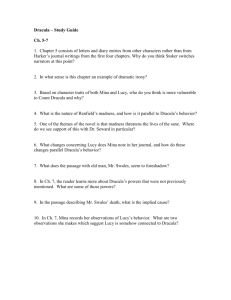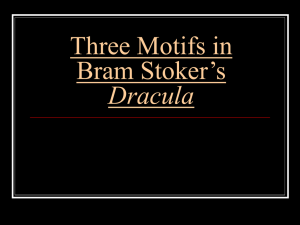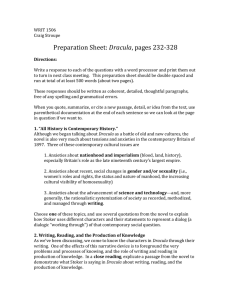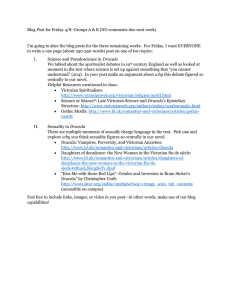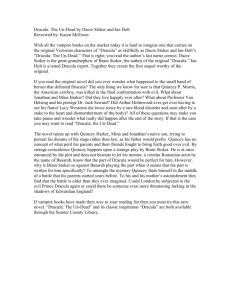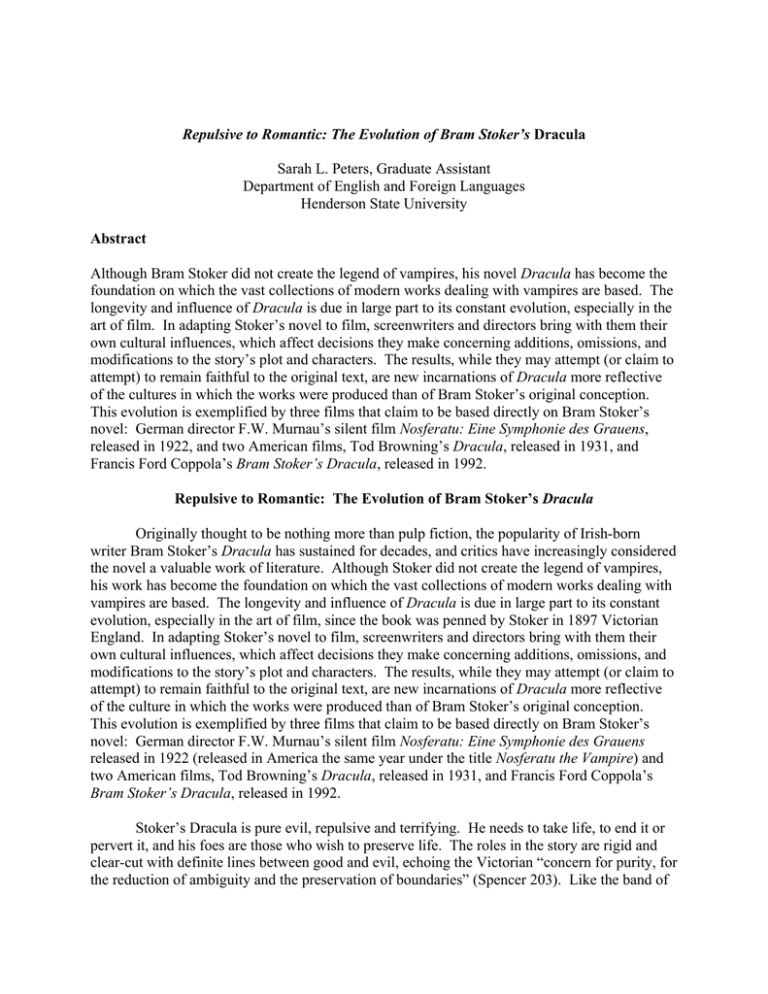
Repulsive to Romantic: The Evolution of Bram Stoker’s Dracula
Sarah L. Peters, Graduate Assistant
Department of English and Foreign Languages
Henderson State University
Abstract
Although Bram Stoker did not create the legend of vampires, his novel Dracula has become the
foundation on which the vast collections of modern works dealing with vampires are based. The
longevity and influence of Dracula is due in large part to its constant evolution, especially in the
art of film. In adapting Stoker’s novel to film, screenwriters and directors bring with them their
own cultural influences, which affect decisions they make concerning additions, omissions, and
modifications to the story’s plot and characters. The results, while they may attempt (or claim to
attempt) to remain faithful to the original text, are new incarnations of Dracula more reflective
of the cultures in which the works were produced than of Bram Stoker’s original conception.
This evolution is exemplified by three films that claim to be based directly on Bram Stoker’s
novel: German director F.W. Murnau’s silent film Nosferatu: Eine Symphonie des Grauens,
released in 1922, and two American films, Tod Browning’s Dracula, released in 1931, and
Francis Ford Coppola’s Bram Stoker’s Dracula, released in 1992.
Repulsive to Romantic: The Evolution of Bram Stoker’s Dracula
Originally thought to be nothing more than pulp fiction, the popularity of Irish-born
writer Bram Stoker’s Dracula has sustained for decades, and critics have increasingly considered
the novel a valuable work of literature. Although Stoker did not create the legend of vampires,
his work has become the foundation on which the vast collections of modern works dealing with
vampires are based. The longevity and influence of Dracula is due in large part to its constant
evolution, especially in the art of film, since the book was penned by Stoker in 1897 Victorian
England. In adapting Stoker’s novel to film, screenwriters and directors bring with them their
own cultural influences, which affect decisions they make concerning additions, omissions, and
modifications to the story’s plot and characters. The results, while they may attempt (or claim to
attempt) to remain faithful to the original text, are new incarnations of Dracula more reflective
of the culture in which the works were produced than of Bram Stoker’s original conception.
This evolution is exemplified by three films that claim to be based directly on Bram Stoker’s
novel: German director F.W. Murnau’s silent film Nosferatu: Eine Symphonie des Grauens
released in 1922 (released in America the same year under the title Nosferatu the Vampire) and
two American films, Tod Browning’s Dracula, released in 1931, and Francis Ford Coppola’s
Bram Stoker’s Dracula, released in 1992.
Stoker’s Dracula is pure evil, repulsive and terrifying. He needs to take life, to end it or
pervert it, and his foes are those who wish to preserve life. The roles in the story are rigid and
clear-cut with definite lines between good and evil, echoing the Victorian “concern for purity, for
the reduction of ambiguity and the preservation of boundaries” (Spencer 203). Like the band of
men determined to destroy Dracula, the reader has no sympathy for the monster that destroys
lives without remorse. In an entry of her journal, Mina says of Dracula, “I suppose anyone ought
to pity any thing so hunted as is the Count. That is just it: this Thing is not human—not even
beast. To read Dr. Seward’s account of poor Lucy’s death, and what followed, is enough to dry
up the springs of pity in one’s heart” (Stoker 186).
Indeed, Stoker describes a monster that is inhuman and undeserving of human sympathy.
When Harker meets the Count in his home for the first time, he writes a detailed account of the
creature’s “marked physiognomy” in his journal:
His face was […] aquiline, with high bridge of the thin nose and peculiarly arched nostrils; with
lofty domed forehead, and hair growing scantily around the temples but profusely elsewhere.
His eyebrows were very massive, almost meeting over the nose, and with bushy hair that seemed
to curl in its own profusion. The mouth, so far as I could see it under the heavy moustache, was
fixed and rather cruel-looking, with peculiarly sharp white teeth [that] protruded over the lips
[…]; his ears were pale, and at the tops extremely pointed […]. The general effect was one of
extraordinary pallor. (Stoker 59)
Harker goes on to describe the beast-like qualities of the count, such as the hairy palms and the
long, claw-like nails cut to a sharp point. When Harker finds Dracula asleep in his coffin with
fresh blood on his lips, the Count looks younger and healthier, but he is still repulsive, described
by Harker as a disgustingly “bloated” creature “gourged with blood,” a “filthy leech” (80). All
words used to describe Dracula are negative, and everyone who sees him is revolted.
Influenced by his environment in devastated post-World War I Germany, Murnau
includes Dracula’s every horrible feature in Nosferatu, perhaps making him even more hideous
than Stoker imagined him. His skeletal body and skull-like head combined with the rodent-like
features of pointed ears and protruding front teeth make Murnau’s Nosferatu (Count Dracula) a
“specter of death” (Perez). He has few human characteristics, and his face displays no emotion
throughout most of the film. He is unquestionably horrible. However, Murnau adds a small
element to the story that gives Nosferatu a human side in the form of a weakness for Nina (the
alternate name for Harker’s wife, Mina, which was changed for copyright reasons). When
Harker is at the castle in Transylvania, Nosferatu sees a picture of Nina and comments, “Is this
your wife? What a lovely throat!” (Nosferatu). While this seems at first to imply that he sees
Nina as merely another throat to bite, the relationship develops through a mysterious telepathic
connection between Nina and Nosferatu. Nosferatu’s move to the city then shifts from a quest
for new blood to a journey towards Nina. The story builds up to the point that they finally meet,
and the final shot is of the vampire leaning over Nina’s dead body, staring at her in pathetic
helplessness as he dies with the rising of the sun. This revelation of emotion and pain as he
diminishes evokes a kind of reluctant sympathy for the devastated creature despite the death he
has brought to the city.
While no love story is present in Browning’s Dracula, this film introduces a variation
that removes much of the hideous, animalistic quality so important to previous versions of the
Count: Count Dracula is an attractive, sophisticated aristocrat who moves about easily in polite
society. This would have been impossible for anyone matching Stoker’s description and
especially for one so obviously non-human as Murnau’s Nosferatu. Both of these earlier
Draculas had to move at night, hiding in shadows, while sleeping in coffins throughout the day,
never making casual contact with humans beyond the meeting with Harker in Dracula’s own
home. Browning’s Dracula, by contrast, is debonair and alluring, especially to Lucy who is
attracted to Dracula romantically before he ever casts his hypnotic powers on her. This
seemingly minor change in the appearance of the character drastically affects the viewers’
responses to a vampire that Stoker originally intended to be too disgusting to appeal to anyone
not trapped by Dracula’s bizarre powers (Hensley 89). Dracula’s new form, including the slick
hair, black cape, and high arched eyebrows (nothing close to the curly, bushy brows of Stoker’s
vampire) made famous by Bela Lugosi’s performance, became the best known and most often
repeated image of the Count in subsequent films. The reasons for the popularity of this image of
Dracula may be twofold: viewers can more easily relate to a villain that looks human, and a
monster in disguise that can blend into society is more threatening than one trapped in shadows
by his hideous appearance.
The sympathy a viewer may feel for Browning’s Dracula, however, ends with the
attractive appearance. The love story hinted at in Nosferatu is gone, and once again Dracula is
motivated only by the desire for blood. Faithful to Stoker’s text, Dracula moves to London not
to search for Mina but to gain easy access to large numbers of people who will become their
victims. His selection of victims is of convenience. Because he cannot enter a house unless he
has been invited, he takes his victims from the house of the man from whom he has bought his
London property. Dracula introduces himself to the family and visits them socially while at
night he enters the bedrooms of Lucy and Mina in the form of a bat to drink their blood and
convert them to vampires. He takes Mina to his home not out of love for her but in order to take
vengeance on the men who have discovered his identity and to fulfill his demonic duty to
produce more undead like himself. Dracula’s face is not seen when Van Helsing kills him, so
the viewer has no opportunity to develop sympathy for his pain. His death is the end of an evil
monster as well as the cure for the evil he has implanted in the innocent Mina.
Maintaining the image of a human Dracula moving comfortably within society, Coppola
revives the powerful connection between Mina and Dracula introduced by Nosferatu and
escalates it into an elaborate love affair complete with a centuries-old history and a new origin of
the evil Count. Stoker offers only a vague history of the Count, calling him a brave and clever
warrior with “iron resolution” who deals with the devil (193). Although his notes for the novel
reveal extensive studies on vampire legend and history, Stoker plays down the origin of the
vampire, limiting the knowledge of the reader to Van Helsing’s knowledge of the superstitious
legend (McNally and Florescu 18). In a story where his satanic contract is left a mystery,
Dracula’s actions are motivated by an unknown evil source. In an extended prologue to the film
Bram Stoker’s Dracula, however, Coppola presents an origin that refers to Vald Dracul, or Vlad
the Impaler, the historical figure to which Dracula’s legend is attributed (49). Dracula is seen as
a fearless warrior who joins the Crusades to defend Christianity, praying for the protection of his
beloved wife Elisabetha while he is gone. After defeating the Turks and impaling his enemies on
long spikes, Vlad returns to discover that Elisabetha has killed herself after hearing false news of
his death. Enraged, he renounces God and pledges his life to the devil. Dracula’s motivation
throughout the film is the pursuit of his lost love, reincarnated in Mina Harker, and the traditional
theme of the pursuit of blood is subordinated (Corbin and Campbell).
Dracula the vampire first appears as an ugly old man when Harker travels to Transylvania
to meet him and to secure Dracula’s purchase of a London property. While in Transylvania,
Dracula is the frightening, repulsive beast of Stoker’s novel, but the viewer is reminded of the
heart-broken prince by a large portrait of him on the castle wall (“I see the resemblance,”
remarks Harker) and by Dracula’s reaction to seeing the photograph of Mina that Harker has
carried with him. Upon seeing it, Dracula, with tears in his eyes, admits to Harker, “I loved
once,” and immediately the viewer sees past the grotesque exterior to the lovesick prince (Bram
Stoker’s Dracula). The revival of Dracula’s youth after feeding that Stoker described is dramatic
in Coppola’s film, as the terrible Dracula becomes the young, attractive, and exotic Prince Vlad.
This persona is separated from Dracula’s evil actions in London, such as his attack on Lucy. He
only appears as Prince Vlad when he is with Mina; everywhere else he is a bat, wolf, mist, or
another of his many shapes.
In a true romantic spirit, Vlad does not immediately take Mina, as the viewer knows he
can. Instead, he meets her on the streets of London as an intriguing stranger and courts her until
Mina falls in love with him. When Mina is alone and Dracula comes to claim his bride, she
welcomes him and begs him to make her immortal so that she can be with him forever. He cries
and tells her, “I love you too much to condemn you,” but Mina insists that she wants to be with
him and voluntarily drinks his blood (Bram Stoker’s Dracula). In this scene, Dracula is not an
evil force but a man in love who is willing to sacrifice his opportunity to be reunited with his lost
wife to do what is best for her. The responsibility of Mina’s conversion to a vampire is not
Dracula’s but her own, a decision she makes out of love for him.
The vulnerable, loving character of Coppola’s Dracula stirs the viewer’s sympathy more
than previous versions. The vile, untouchable creature has become the tragic demon lover.
Dracula’s death, then, is not a victory for the good force that has rid the earth of a terrible evil; it
is, instead, an act of love by Mina’s hand (similar to Nosferatu, but a contrast to Stoker’s and
Browning’s Draculas who are killed by men protecting Mina) that released the soul of the
damned lover so that he may rest peacefully.
Sexuality, especially the enigma of sexual pleasure derived from an oddly erotic death, is
a theme commonly associated with vampires, representing “a form of sexuality that contrasts
with socially acceptable expressions of sexuality” (Wyman). The bite on the victim’s neck
occurs in a kind of intimate embrace, violating the victim through penetration of the skin with
the vampire’s fangs. Even as the victims know that the bite dooms them to death—or undeath at
the discretion of the attacker—they feel compelled not to resist, entranced by a supernatural
force at the command of the vampire, making the attack more of a seduction than a rape (Spencer
217). Stoker’s novel presents veiled sexual themes in a context of Victorian values, warning
against the danger of desire derived from the fear of syphilis that was prevalent in Victorian
England (Unrau). The vampire’s bite infects his victim, leading to death or to the infection of
others by the victim, a carrier of the “disease” of vampirism.
Harker, isolated from his fiancé and therefore vulnerable to seduction, experiences the
first dangerous sexual encounter when he meets Dracula’s three brides who live in the castle.
The women are strikingly beautiful with a “deliberate voluptuousness that was both thrilling and
repulsive” (Stoker 72). As one of the women leans over him, he detects the odor of blood in her
breath, a reminder of the impending death if he betrays his values and succumbs to the
temptation. Harker expresses feelings of guilt at his “burning desire” for the women, but closes
his eyes in “languorous ecstasy,” unable to resist them (72). He is saved from impending sin and
impending death, not by his virtue but by the evil Count, who enters and casts the women away.
This equation of sex with death continues with Lucy Westenra, a young woman whose sin is to
enjoy being pursued by three men and her wish that she could marry them all. While Lucy
remains virtuous and shows no evidence of sexual promiscuity, her attitude toward the proposals
of the three men is unacceptable by Victorian standards and it makes her a target for the
vampire’s attack. Compounding Lucy’s vulnerability is her lack of protection; she has no father
or brothers, and her mother is both physically and psychologically weak (Spencer 209). Dracula
attacks Lucy when she wanders outside while sleepwalking (also traditionally associated with
sexual looseness), after which she must have several blood transfusions to keep her alive for the
few days that she survives following the attack (Spencer 210). She receives the blood of all three
of the men who proposed to her plus that of Dr. Van Helsing, connecting her physically to those
men and morbidly fulfilling her wish to marry three men. She is punished with death, first by
Dracula, who converts her to an undead vampire, and then by her several “husbands,” who drive
a stake through her heart and cut off her head.
The only woman able to resist Dracula’s power is the intelligent and innocent Mina. To Dracula,
Mina is an object to be used to punish the men who love her and hunt him, and he uses her love
for her husband against her, keeping her quiet while he drinks her blood even as her husband
sleeps beside her. As she tries to resist him, even the dutiful wife becomes a victim of
seduction: “I was bewildered, and strangely enough, I did not want to hinder him” (Stoker 222).
Later, Dracula forces Mina to drink his blood, which dooms her to become a vampire, another
one of Dracula’s brides, at her death. She is determined to fight her curse, however, and lives to
see Dracula killed, healing her of the disease so that she may live once again as a devoted wife
and, later, mother, the role that keeps her safe from the danger of the disease brought on by the
unnatural, adulterous encounters with the vampire.
Sexual themes are repressed significantly in Murnau’s Nosferatu. The brides are non-existent,
and Lucy’s character is reduced to little more than scenery. The only significant presence of a
woman is that of Nina, the salvation of the world and the destruction of Nosferatu at the expense
of her own life. The final scene of the film depicts Nina’s self-sacrifice to Nosferatu in a
moment that appears as a pathetic love scene, but there is little sexuality in it. We see only
Nosferatu’s face looking up from Nina’s body just before Harker and Van Helsing enter to see
the dead Nina and the dying Nosferatu. The theme of desire, represented by Nina’s unusual
psychic connection to Nosferatu and her decision to give herself to him paralleled with Jonathon
Harker’s lust for money, becomes a theme of “anxieties about the bourgeois family and its
potential ability to contain the desire of both partners” (Unrau). Harker’s desire for money leads
him to take the real estate job in Transylvania with Count Dracula, despite his employer’s
warning that “it may cost [him] some blood” (Nosferatu). Nina, seen knitting, as a dutiful wife
should, begs Harker not to leave her, but his money-lust is stronger than his desire to be with her,
and he leaves her alone. His absence leads to the introduction of Nosferatu into their lives and
into their town. The results of his unhealthy desire is seen in Harker’s change from a childish
exuberance to restrained defeat over the course of the film, and the ultimate consequence is the
destruction of their family when Nina dies, giving her life to Nosferatu in order to end the curse
of death on the town.
Tod Browning’s Dracula, filmed in pre-sexual revolution America, brings sexual themes more
strongly back into the story, but with conservative restraint. As in Stoker’s novel, Browning’s
film implies sexuality rather than explicitly displaying it. Lucy returns to the story, a beautiful
and flirtatious young woman who playfully fantasizes about the exotic Count Dracula she meets
at a play. She is curious and innocent, but her attraction to the Count is enough to make her the
perfect choice to be his first victim in London. Dracula enters Lucy’s bedroom in the form of a
bat and approaches her bed, leaning close to her neck. The scene ends promptly with no bite
ever shown. After a short illness, Lucy is dead. Dracula later attacks Mina, as well, in much the
same way, although he goes farther with her, taking her to his home in London where he rests in
his coffin, presumably making her a fourth bride. The concept of sex related to death is subdued,
presented in a scene following Dracula’s attack on Mina when she, revealing sharp teeth and
staring hungrily at Jonathon’s neck, begs him to kiss her. All seduction is done through glances,
as Dracula uses his psychic powers to hypnotize his victims into submission, and there is no
scene of sexual pleasure derived through the actual vampire bite.
By 1992, Coppola’s Dracula has abandoned all restraint and is blatantly sexual, with erotic
pleasure becoming as important in the vampire’s attack as is the consumption of blood. The age
of AIDS brings death in sex back to the forefront, and much more lenient censors allow for
graphic depictions of nudity and sexual activities in the film. Moreover, the women of the story
take on a new responsibility, becoming “active agents” in the sexual play (Corbin and
Campbell). They are deliberate choices for Dracula because they are objects of his sexual
desires, and the female vampires are as sexually powerful as Dracula himself. Dracula’s halfnude brides, appearing more obviously than ever as a harem, molest Jonathan Harker in a surreal,
mystical orgy, simulating fellatio and other sexual acts while flashing sharp teeth and evil glares,
appearing frightening and horrible but also sexually arousing to Harker, who is helplessly in their
control.
Lucy takes on her full role in the plot, this time as an overtly sexual temptress, complete with
fiery red hair and lace negligee. Lucy floats from suitor to suitor, demanding their attention, and
teases the more reserved Mina about being prudish. Dracula’s attack on Lucy becomes an act of
deviant sexuality. Mina finds Lucy outside, lying on her back with her breasts and thighs
exposed under her red negligee as a wolf-like beast is mounted between her legs, his teeth
dripping with blood. Lucy is in Dracula’s power after that, selected by the Count to become “a
whore of darkness,” “the devil’s concubine” (Bram Stoker’s Dracula).
Far from Stoker’s original depiction, Coppola’s Dracula also awakens a fierce sexuality in Mina,
as her initial meetings with him lead to sexual fantasies and a final love scene of bloody
eroticism. Early in the film, Mina is reserved; she shies from sexual contact and conversation. It
is only after she meets Dracula, who appears under the guise of Prince Vlad, that she develops an
interest in sex, and Dracula, not her husband, becomes Mina’s first experience of sexual desire.
In an elaborate, hallucinatory scene, Vlad introduces Mina to absinthe and attempts to rape her
while she is in her drugged state, but his love for her stops him. He cannot bring himself to
violate her as he did the lascivious Lucy; she must invite him into the activity. When Mina
leaves to care for Harker and to marry him, she begins having fantasies about Vlad, her desire for
him becoming more powerful than her love for her husband. When Dracula comes to her room,
she tears at her clothes and begs him to take her—to drink of her blood and to feed her his own
so that she may become his undead bride. In an act mimicking fellatio, Mina, panting and
moaning desperately, sucks at the cut that Dracula has opened on his body. Where Stoker
alludes to morbid sexual pleasures, Coppola presents them explicitly, making no veiled
insinuations and leaving nothing to imagination.
In vampire lore and in Stoker’s novel, religion and religious paraphernalia play an
important role as the protector of the innocent and the weakness of Dracula. In the novel,
Christianity mixes with superstition, juxtaposing English Protestantism with Carpathian
barbarianism, as humanity’s only defense against Satan in the shape of the vampire. Stoker
introduces this theme immediately when Harker encounters trouble traveling to Dracula’s castle
in Transylvania. When the native peasants hear where he is going, they beg him to wait because
it is Walpurgis Nacht, “when, according to the belief of millions of people, the devil was
abroad—when the graves were opened and the dead came forth and walked. When all evil
things of earth and air and water held revel [sic]” (Stoker 40). Harker responds to superstitions
with practical English doubt, telling the frightened coachman, “Walpurgis Nacht doesn’t concern
Englishmen” (37). Again the fear of the locals is thrust upon Harker by an old woman, who
pleads on her knees for him to change his mind. When she finds him determined to go, she
places a crucifix around his neck for protection, which Harker, “as an English Churchman,”
regards as “in some measure idolatrous” (51). He takes the rosary to appease the old woman and
travels to the castle.
These scenes set up Harker as a skeptic entering a realm of supernatural power that he cannot
comprehend, and though he does not realize it, the Carpathian peasant woman has given him
effective protection from that power. Harker has faith in God and prays at his first feeling of
fear, but he must be convinced of the power of the physical symbols of religion traditionally
rejected by English Protestantism. His conversion begins when he is helplessly trapped in the
castle and his only comfort can be found in the gifts of the peasants. He writes in his journal:
What meant the giving of the crucifix, of the garlic, of the wild rose, of the mountain ash? Bless
that good, good woman who hung the crucifix around my neck! for it is a comfort and strength to
me whenever I touch it. It is an odd thing that something I have been taught to regard with
disfavor and as idolatrous should in a time of loneliness and trouble be of help. (65)
Harker does not readily accept the true power of the symbol, even when he sees Dracula recoil at
the sight of it. As the story develops, however, Harker abandons the teachings of his youth and
recognizes the work of supernatural powers beyond his understanding.
Stoker’s Van Helsing quite obviously represents science’s part in Victorian life, and
using him, Stoker demonstrates the limitations of science when Van Helsing abandons all
rational scientific theory for the study of vampires and the most effective weapons against them.
Van Helsing, the leader of the band raised up against Dracula, guides them through the process
of destroying first the vampire Lucy and then Dracula himself. Modern medicine, Van Helsing’s
first weapon in the battle for Lucy Westenra’s life, fails when Lucy’s multiple blood transfusions
do not keep her from mysteriously losing blood night after night. Even while still relying on
medicine, Van Helsing adds the superstitious protection of a garlic wreath around Lucy’s neck
and garlic on the window, though an unknowing servant removes them. Lucy’s death proves the
futility of science and medicine against this greater power, and Van Helsing abandons his
traditional practice in favor of the more effective relics—garlic, crosses, and sacramental
wafers—and rituals—driving a stake through the vampire’s heart, cutting off the head, and
stuffing the mouth with garlic. Contrary to science and medicine, these practices are invariably
effective in staving off and destroying the vampires. As Van Helsing states, acknowledging their
need to rely on powers outside scientific boundaries, “All we have to go on are superstitions and
traditions […]. A year ago which of us would have received such a possibility, in the midst of
our scientific, matter-of-fact nineteenth century?” (Stoker 192).
By contrast, religious and superstitious paraphernalia are conspicuously absent in
Murnau’s Nosferatu. Harker’s conversion is not one of skepticism to belief but of carefree
innocence to despair. He sees two marks on his neck, evidence of the vampire’s bite, but
laughingly attributes them to insects, and he passes off his strange experiences in the castle as
dreams. However, he cannot ignore the evil around him for long, and he rapidly changes into a
broken, terrified man, hiding under his bed covers when Nosferatu enters the room. Murnau’s
Harker has no crucifix or garlic for comfort. A cross appears in this film only a marker for
graves. Science’s role, personified by Van Helsing, is greatly diminished as well, and Van
Helsing never makes the significant graduation from the scientific to the supernatural. He is
shown only as a lecturer on plants and animals, a device utilized by the filmmaker to display
vampirism in the natural world. When Nina feels the approach of Nosferatu, she orders Harker
to get the professor, but his help is useless because by the time the two return, both Nina and
Nosferatu are dead.
The most significant reason for the omission of the religious and superstitious elements
of the story as well as the minimized role of science is the Nosferatu’s primary theme of
imminent and inevitable death. Produced just a few year after World War I in which millions of
Germans were killed and the threat of political turmoil loomed over the country, Nosferatu was
built on the same foundation as German existentialism and displays much of the same attitudes
in its treatment of death. Nosferatu becomes the embodiment of impending death and
humanity’s futility in the face of it. The number of deaths is significantly greater in this film
than in Stoker’s novel, with scenes depicting rows of coffins being carried through the streets
and an official going from door to door marking the afflicted homes. Nosferatu’s presence in the
city is portrayed as a pestilence, the plague brought by the rats that accompany him. The cross’s
lack of power exhibits the inability of religion to defeat death, even with its promises of afterlife
(Perez). The naïve Jonathan Harker refuses to believe in the danger that he faces until the weight
of it overtakes him, denying his own mortality even in the shadow of death.
Only Nina acknowledges the mortal reality. She waits at the window as Harker and Nosferatu
make concurrent journeys toward her, saying, “He is coming. I must go to him,” ambiguously
referring to her husband or to the vampire (Nosferatu). The only significant relic in the film is
The Book of Vampires, which Nina reads although Jonathan forbids it. She finds her destiny in
the book as she reads, “Only a women can break the spell—a woman pure in heart—who will
offer herself freely to Nosferatu and will keep the vampire by her side until after the cock has
crowed” (Nosferatu). Nina accepts the responsibility and faces her own death. The power of
Nosferatu, the power of death, is overcome by a woman who faces death in the best way, with
quiet resignation and acceptance (Perez).
Influenced by a culture far from the devastation of post-war Germany, Browning’s Dracula
includes Stoker’s religious weapons, but they are portrayed more simplistically than Stoker’s
catalog of relics and rituals. Early American “talkies” appealed to a mass audience, and to a
primarily Christian culture still unexposed to films like the The Exorcist, elaborate scenes of
religious ceremony mixed with pagan beliefs would have been offensive. The characters of this
Dracula rely on Christian faith to protect them from evil, with Eastern superstitions understated
as much as they can be in relation to vampires. The characters have no need for elaborate
ceremony because the crucifix, the only religious symbol that appears in the film, is powerfully
effective against Dracula. They must only show the cross to the vampire to render him
powerless against them. The only ritual performed is that of killing the vampire, included out of
necessity.
Van Helsing undergoes no conversion from his reliance on science to reliance on primitive
beliefs. From the beginning, he is familiar with the legend of the vampire, how to recognize
him, and how to kill him, so no time is spent among the characters debating the nature of their
foe. After he explains it matter-of-factly to the others, Van Helsing’s knowledge of vampirism is
taken for granted and acted upon without addressing the Western skepticism that is such a
prominent theme in Stoker’s novel. Avoiding the themes of the limitations of science and the
coexistence of Christianity and paganism allows for a less controversial film with mass appeal,
but leaves viewers with a one-dimensional story and a movie valuable as an example of early
filmmaking more than as a profound work of art.
Sixty years after Browning’s production, however, Coppola has the luxury of the permissive and
excessive late-twentieth century attitudes toward film, and his Dracula far exceeds Stoker’s in its
use of religious symbols and rituals. Made for a culture that embraces the exotic and where the
influence of the Christian church has significantly declined, the religious elements of Coppola’s
film are created for entertainment and effect. When used to fight Dracula, these faith-based
weapons are not as immediately effective as they are in Stoker’s novel. The crucifix, the most
prominent religious icon in vampire lore, repels Dracula, but it seems merely an annoyance that
the vampire’s power can overcome with force. When the men go to Dracula’s home to destroy
him, Van Helsing sets up an elaborate scene of relics and flames to perform a ritual of exorcism
on the castle. Dracula has no concern, however, as he is transforming Mina into an undead at the
same time that the men are performing their extravagant ritual. Failing to find Dracula in Carfax
Abbey, they return to Mina and find him with her. He transforms from the beautiful prince into a
hideous man-sized bat and attacks the men, and Van Helsing begins another exorcism ritual,
throwing Holy Water on the creature and shouting incantations. In this scene, Mina receives a
burn on her forehead when Van Helsing presses a sacramental wafer against her skin, leaving a
scar that she must carry until Dracula is dead. This mark, reminiscent of the Biblical mark of
Cain, is one of the few phenomena related to religion that corresponds to Stoker’s novel.
Throughout the film, the religious elements are exaggerated further and further beyond Stoker’s
story, but those weapons do not succeed in defeating Dracula.
Van Helsing’s role as the tie between science and the supernatural is apparent in this film.
Faithful to Stoker’s character, Van Helsing is a scientist first and foremost, looking for empirical
evidence to determine the cause of Lucy’s illness. He tries modern methods of blood transfusion
and does not consider possibilities beyond science until his initial attempts to cure her fail
(Perez). However, he is not reluctant to accept the limitations of science but rather embraces the
idea that there are realms that science cannot touch. He sums up his attitude in his exchange
with Seward when the men are perplexed over Lucy’s mysterious blood loss: “Jack, you are a
scientist. Do you not think there are things in this universe that you cannot understand and
which are true? Mesmerism, hypnotism, materialism…” (Bram Stoker’s Dracula). This
statement sets the tone for the film as a meeting of the real and scientific with the mystical and
unexplainable where nothing may be taken for granted, a theme present in Stoker’s novel but
even more significant in Coppola’s adaptation. Despite the stated acceptance of the spiritual and
supernatural, Coppola betrays this theme when the vampire’s strength overpowers all religious
and superstitious weapons used against him. He in unhindered by the men’s rituals and is only
defeated when overpowered and destroyed physically, creating a scientific ending to a
supernatural story.
In the course of Count Dracula’s mythic existence, he has transmutated from a hideous monster
to a mysterious seducer, from an inhuman beast of unquestionable evil to a complex human
evoking a strange sympathy and blurring the lines between good and evil. Filmmakers and
storytellers recreate him continually, adding new elements each time, perpetuating the evolution
of this character who has made his way into our collective consciousness. Perhaps the true
immortality of Dracula exists in his ability to take on new and ever-changing forms that allow
him to fit into every culture.
Works Cited
Corbin, Carol, and Robert A. Campbell. “Postmodern Iconography and Perspective in Coppola’s
Bram Stoker’s Dracula.” Journal of Popular Film and Television, 27.2 (Summer 1999): 40-49.
EBSCOHost. Huie Library, Henderson State University, Arkadelphia, AR. 1 April 2002.
<http://search.epnet.com>.
Bram Stoker’s Dracula. Dir. Francis Ford Coppola. Perf. Gary Oldman and Winona Ryder.
Columbia Pictures, 1992.
Dracula. Dir. Tom Browning. Perf. Bela Lugosi and Helen Chandler. Universal Pictures, 1931.
Hensley, Wayne E. “Stoker’s Dracula.” Explicator, 58.2 (2000): 89-90.
McNally, Raymond, and Radu Florescu. The Essential Dracula. New York: Mayflower, 1979.
Nosferatu. Dir. F. W. Murnau. Perf. Max Schrek, Gustav von Wangenheim, and Greta
Schröder. Jofa-Atelier Berlin-Johannistal, 1922.
Perez, Gilberto. “Nosferatu.” Raritan 13.1 (Summer 1993): 1-29. EBSCOHost. Huie Library,
Henderson State University, Arkadelphia, AR. 1 April 2002. <http://search.epnet.com>.
Spencer, Kathleen L. “Purity and Danger: Dracula, The Urban Gothic, and the Late Victorian
Degeneracy Crisis.” English Literary History 59.1 (1992): 197-226.
Stoker, Bram. Dracula. The Essential Dracula. Raymond McNally and Radu Florescu. New
York: Mayflower, 1979. 35-277.
Unrau, Rona. “Eine Symphonie des Grauens or The Terror of Music: Murnau’s Nosferatu.”
Literature Film Quarterly 27.3 (1996): 234-240. EBSCOHost. Huie Library, Henderson State
University, Arkadelphia, AR. 1 April 2002. <http://search.epnet.com>.
Wyman, Leah and George N. Dionisopoulos. “Primal Urges and Civilized Sensibilities.”
Journal of Popular Film and Television 27.2 (Summer 1999):32-40. EBSCOHost. Huie Library,
Henderson State University, Arkadelphia, AR. 1 April 2002. <http://search.epnet.com>.
Biographical Sketch
Sarah L. Peters is a Graduate Assistant in the Department of English and Foreign Languages is
currently pursuing a Master of Liberal Arts in English. She received her B.A. in English from
Henderson State University in 2001, and she is a member of Alpha Epsilon Lambda Graduate
Honor Society.
Disclaimer: Henderson State University and the Office of Computer and Communication Services assume no responsibility for any information or representations contained in the
student/faculty/alumni web pages. These web pages and any opinions, information or representations contained therein are the creation of the particular individual or organization and do not
necessarily reflect the opinion of Henderson State University or its Office of Computer and Communication Services. All individuals publishing materials on the Henderson State University Web
Server understand that the submission, installation, copying, distribution, and use of such materials in connection with the Web Server will not violate any other party's proprietary rights.

